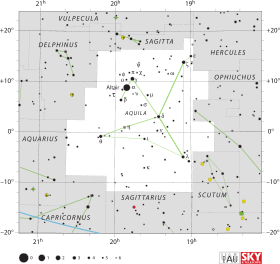HD 180262
HD 180262
| Ascension droite | 19h 15m 20,08999s[1] |
|---|---|
| Déclinaison | +15° 30′ 01,5408″[1] |
| Constellation | Aigle |
| Magnitude apparente |
5,57[2] (5,75 + 7,69)[3] |
Localisation dans la constellation : Aigle | |
| Type spectral | G8II-III + A1V[3] |
|---|---|
| Indice U-B | +0,85[2] |
| Indice B-V | +1,10[2] |
| Indice R-I | 0,54 |
| Vitesse radiale | −25,2 km/s[4] |
|---|---|
| Mouvement propre |
μα = +0,55 mas/a[1] μδ = −11,10 mas/a[1] |
| Parallaxe | 5,32 mas[1] |
| Distance | ∼ 600 a.l. (∼ 184 pc) |
| Rayon | 50 R☉[5] |
|---|---|
| Gravité de surface (log g) | 2[6] |
| Luminosité | 323 L☉[7] |
| Température | 4 308 K[8] |
| Métallicité | 0,21[8] |
| Rotation | 1,4 km/s[6] |
Désignations
HD 180262 est une étoile double de la constellation de l'Aigle. La paire a une séparation angulaire de 89,823"[3].
Notes et références[modifier | modifier le code]
Notes[modifier | modifier le code]
- (en) Cet article est partiellement ou en totalité issu de l’article de Wikipédia en anglais intitulé « HD 180262 » (voir la liste des auteurs).
Références[modifier | modifier le code]
- F. van Leeuwen, « Validation of the new Hipparcos reduction », Astronomy and Astrophysics, , p. 653–664 (DOI 10.1051/0004-6361:20078357, Bibcode 2007A&A...474..653V, arXiv 0708.1752, S2CID 18759600)
- J.-C. Mermilliod, « Compilation of Eggen's UBV data, transformed to UBV (unpublished) », Catalogue of Eggen's UBV Data, (Bibcode 1986EgUBV........0M)
- P. P. Eggleton et A. A. Tokovinin, « A catalogue of multiplicity among bright stellar systems », Monthly Notices of the Royal Astronomical Society, , p. 869–879 (DOI 10.1111/j.1365-2966.2008.13596.x, Bibcode 2008MNRAS.389..869E, arXiv 0806.2878, S2CID 14878976)
- G. A. Gontcharov, « Pulkovo Compilation of Radial Velocities for 35 495 Hipparcos stars in a common system », Astronomy Letters, , p. 759–771 (DOI 10.1134/S1063773706110065, Bibcode 2006AstL...32..759G, arXiv 1606.08053, S2CID 119231169)
- L. E. Pasinetti Fracassini et al., « Catalogue of Apparent Diameters and Absolute Radii of Stars (CADARS) - Third edition - Comments and statistics », Astronomy and Astrophysics, , p. 521–524 (DOI 10.1051/0004-6361:20000451, Bibcode 2001A&A...367..521P, arXiv astro-ph/0012289, S2CID 425754)
- A. Lèbre, P. de Laverny, J. D. Do Nascimento et J. R. de Medeiros, « Lithium abundances and rotational behavior for bright giant stars », Astronomy and Astrophysics, , p. 1173–1179 (DOI 10.1051/0004-6361:20053485, Bibcode 2006A&A...450.1173L)
- I. McDonald et al., « Fundamental Parameters and Infrared Excesses of Hipparcos Stars », Monthly Notices of the Royal Astronomical Society, , p. 343–57 (DOI 10.1111/j.1365-2966.2012.21873.x, Bibcode 2012MNRAS.427..343M, arXiv 1208.2037, S2CID 118665352)
- Jesse L. Greenstein et Philip C. Keenan, « Abundances of Metals, CN, and CH in Giant Stars », Astrophysical Journal, (DOI 10.1086/146449, Bibcode 1958ApJ...127..172G)
Liens externes[modifier | modifier le code]
- Ressource relative à l'astronomie :

